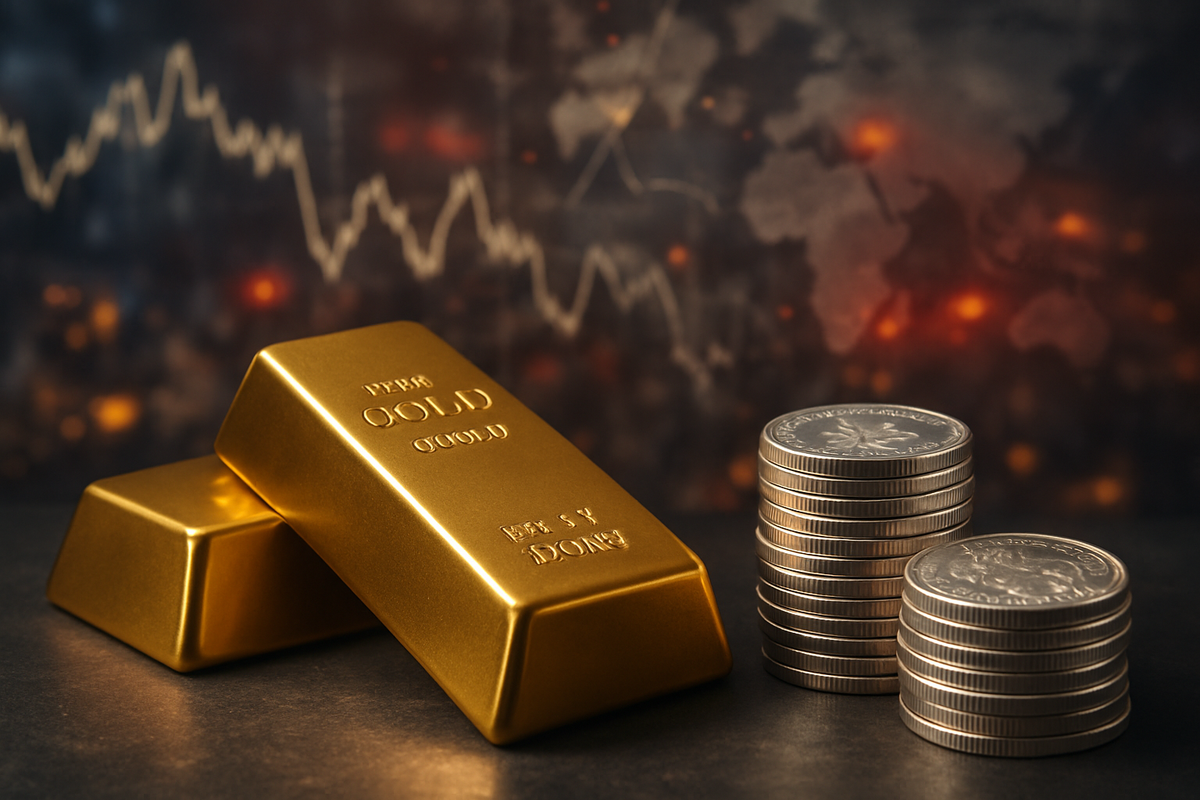
The global financial landscape is once again captivated by the resurgent allure of gold and silver. In a period marked by escalating geopolitical tensions, persistent economic uncertainties, and shifting monetary policies, both precious metals have experienced a dramatic rebound, reaching unprecedented nominal highs by October 2025. This significant rally, while punctuated by recent corrections, signals a profound recalibration in investor sentiment, as market participants increasingly seek safe-haven assets and hedges against inflation and systemic risk. The immediate implications are clear: a renewed focus on the fundamental role of precious metals in diversified portfolios and a potential reshaping of investment strategies for the foreseeable future.
The Meteoric Rise and Subsequent Correction of Precious Metals
The journey of gold and silver prices leading up to October 23, 2025, has been nothing short of extraordinary. Gold's remarkable ascent began in late 2023, with prices surging over 60% since the start of 2025 alone, shattering the $3,000 per ounce barrier by mid-2025. It reached an all-time nominal high of approximately $4,379.96 per ounce on October 16, 2025, before settling around $4,323.69 per ounce on October 21, 2025. Similarly, silver experienced an even more explosive rally, soaring by 45% in the same period, almost doubling its price over the past year, and touching a new all-time high of $52.64 per ounce by October 13, 2025.
This historic surge was primarily fueled by a confluence of factors. Persistent global economic uncertainty, comparable to the peak of the COVID-19 pandemic, accounted for a substantial portion of gold's rise. Inflationary pressures across major economies spurred demand for precious metals as a hedge against currency debasement. Expectations of aggressive interest rate cuts by central banks, particularly the U.S. Federal Reserve, throughout 2025, reduced the opportunity cost of holding non-yielding assets. Furthermore, escalating geopolitical tensions—from renewed U.S.-China trade conflicts and the ongoing Russia-Ukraine war to heightened instability in the Middle East—amplified safe-haven demand. Central banks worldwide, notably in Asia and the Middle East, engaged in record-breaking gold purchases, exceeding 1,000 tonnes annually in 2023 and 2024, driven by de-dollarization efforts and a desire for reserve diversification. For silver, robust industrial demand from green technologies like solar panels and electric vehicles, coupled with persistent supply deficits, provided additional tailwinds.
However, the rapid appreciation was followed by sharp, albeit temporary, corrections. In the latter half of October 2025, gold experienced a 5.4% drop from its peak, while silver saw an even more pronounced 8% fall. These corrections were largely attributed to widespread profit-taking after the rapid gains, concerns that the metals had become overvalued, and a temporary easing of U.S.-China trade tensions. Despite this volatility, many market observers viewed these adjustments as a "healthy market correction," and dips were often seen as "buy the dip" opportunities, reflecting underlying bullish sentiment.
Winners and Losers in the Precious Metals Market
The volatility in gold and silver prices has created a dynamic environment, distinguishing winners and losers across various sectors, from mining companies to exchange-traded funds (ETFs) and related industries.
Mining Firms (Gold): Companies with lower "all-in sustaining costs" (AISC) and efficient operations have been significant beneficiaries. Barrick Gold Corporation (NYSE: GOLD) exemplifies this, reporting substantial increases in revenue, profit margins, and free cash flow in 2025, driven by higher realized gold prices. Its net earnings rose 26% in Q1 2025 to $672 million. Newmont Corporation (NYSE: NEM), the world's largest gold miner, has also been well-positioned, solidifying its global leadership through strategic acquisitions. Smaller exploration and development companies, such as Talisker Resources (TSX: TSK) and Troilus Gold (TSX: TLG), have seen impressive year-to-date gains of 390.63% and 347.46%, respectively, in 2025. Conversely, high-cost gold producers face compressed profit margins during corrections, potentially leading to project re-evaluations or asset divestitures.
Mining Firms (Silver): Silver producers focused on high-grade, low-cost projects, particularly those benefiting from industrial demand, have thrived. Fresnillo PLC (LSE: FRES), the world's largest primary silver producer, reported a 297% increase in profit in the first half of 2025, driven by higher prices despite lower production volumes. MAG Silver (MAG) (NYSE: MAG) (TSX: MAG), with its focus on the high-grade Juanicipio project, saw its stock surge 40% over the last year. Santacruz Silver (TSXV: SCZ) also posted an impressive 765.45% year-to-date gain in 2025. Weaker manufacturing data or sustained price declines could negatively impact high-cost silver producers and those heavily reliant on industrial demand.
ETFs (Exchange Traded Funds): Gold and silver ETFs have been clear winners, directly reflecting the price appreciation. In 2025, gold-based ETFs offered an average return of 40.10% year-to-date, while silver ETFs averaged around 42.67%. Funds like SPDR Gold Shares (NYSEARCA: GLD) and iShares Gold Trust (NYSEARCA: IAU) have seen substantial inflows. During corrections, however, these ETFs experience direct impacts on their net asset values, as seen with declines of over 4% for gold ETFs and nearly 8% for silver ETFs during the October 2025 profit-taking phase.
Other Related Entities: Industries consuming gold and silver as raw materials, such as electronics, solar panel manufacturing, and the automotive sector, may benefit from reduced input costs during price corrections, enhancing their competitiveness. Conversely, mining equipment manufacturers and service providers might face decreased demand if miners scale back capital expenditures due to profit margin compression. Precious metal refiners and traders also navigate challenges in inventory management due to price volatility.
Broader Significance and Historical Context
The current precious metals rally is more than just a cyclical upswing; it represents a significant shift within broader industry trends and the global economic paradigm. Gold's role as an inflation hedge remains paramount amidst persistent price pressures. Geopolitical instability, ranging from conflicts in Eastern Europe and the Middle East to U.S.-China trade disputes, continues to drive safe-haven demand, solidifying gold's status as a crisis commodity.
The unprecedented central bank accumulation, with purchases exceeding 1,000 metric tons in both 2023 and 2024, underscores a strategic "dollar diversification story." This trend is expected to continue, providing a strong floor for gold prices. For silver, its dual identity as both a precious and an industrial metal means its demand is increasingly tied to the burgeoning green energy sector, particularly solar panels and electric vehicles. The global silver market is experiencing its fifth consecutive year of structural supply deficits, with demand consistently outstripping production, a fundamental driver of its price strength. Supply-side constraints, including declining ore grades and permitting delays, further exacerbate this imbalance.
Regulatory bodies are keenly observing market stability, especially given the historical volatility of precious metals. The emergence of tokenized precious metals, regulated by frameworks like the EU's MiCA, signals a move towards greater oversight in digital asset-backed commodities. Historically, precious metals rallies often coincide with periods of high inflation, geopolitical stress, and currency system instability, reminiscent of the 1970s and early 1980s. These historical precedents suggest that while corrections are inevitable, the underlying fundamentals often reassert themselves, leading to stabilization and continued long-term support.
What Comes Next: Navigating the Future of Precious Metals
Looking ahead, the precious metals market is poised for continued dynamism, offering both opportunities and challenges for investors. In the short term (Q4 2025), volatility is expected to persist, influenced by upcoming U.S. CPI reports and evolving U.S.-China trade relations. Investors should prepare for swift price movements and potential further corrections as the market digests recent gains.
However, the long-term outlook for both gold and silver remains overwhelmingly bullish. JPMorgan (NYSE: JPM) analysts forecast gold prices could reach an average of $5,055 per ounce by the fourth quarter of 2026 and reiterate a long-term target of $6,000 per ounce by 2028. This optimistic projection is underpinned by anticipated Federal Reserve interest rate cuts, ongoing stagflation anxieties, and continued central bank buying, which JPMorgan views as a "dollar diversification story." Notably, Jamie Dimon, CEO of JPMorgan, a long-time gold skeptic, has expressed a striking reversal in his stance, acknowledging that gold "could easily go to $5,000 or $10,000 in environments like this." While he doesn't personally buy gold due to ownership costs, he admits it's "one of the few times in my life it's semi-rational to have some in your portfolio," citing high asset prices across the board.
For silver, Bank of America (NYSE: BAC) raised its 2026 forecast to $65 per ounce in October 2025. The persistent supply deficits and growing industrial demand from green technologies are expected to provide strong structural support. Market opportunities may emerge from strategic acquisitions by well-capitalized mining companies, increased exploration spending, and innovation in precious metals-backed financial products. Challenges include potential regulatory shifts, unforeseen geopolitical events, and the inherent volatility that comes with safe-haven assets.
A Comprehensive Wrap-Up: Enduring Significance in an Uncertain World
The recent rebound in gold and silver prices underscores their enduring significance as critical assets in an increasingly uncertain global environment. Key takeaways include the robust demand from central banks and institutional investors, the dual role of silver as both a monetary and industrial metal, and the pervasive influence of economic and geopolitical anxieties.
Moving forward, the market is likely to remain sensitive to macroeconomic data, central bank policies, and the geopolitical temperature. Investors should watch for any shifts in inflation expectations, the pace and timing of interest rate adjustments by major central banks, and developments in international trade relations and conflicts. The long-term trajectory for precious metals appears strong, driven by fundamental demand and their unique properties as hedges against systemic risk. While short-term volatility is to be expected, the strategic importance of gold and silver in portfolio diversification seems cemented for the coming years.
This content is intended for informational purposes only and is not financial advice.





